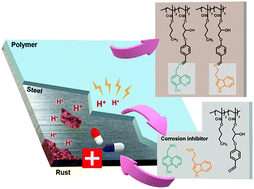Controlling release kinetics of pH-responsive polymer nanoparticles†
Abstract
Polymers with pH-responsive properties are well-known in biomedical applications. We design here polymers that can release payloads upon acidification of their immediate environment. Various corrosion inhibitors such as benzotriazole-5-carbohydrazide, 5-(aminomethyl)-8-hydroxyquinoline, and tryptamine are conjugated to copolymers via imine or hydrazone linkages. Polymer-corrosion inhibitor conjugates displayed a faster release rate of the inhibitor under acidic conditions compared to neutral conditions. Release profiles were controlled by the type of the labile linkage, the nature of the corrosion inhibitor, and by the spacer length.



 Please wait while we load your content...
Please wait while we load your content...